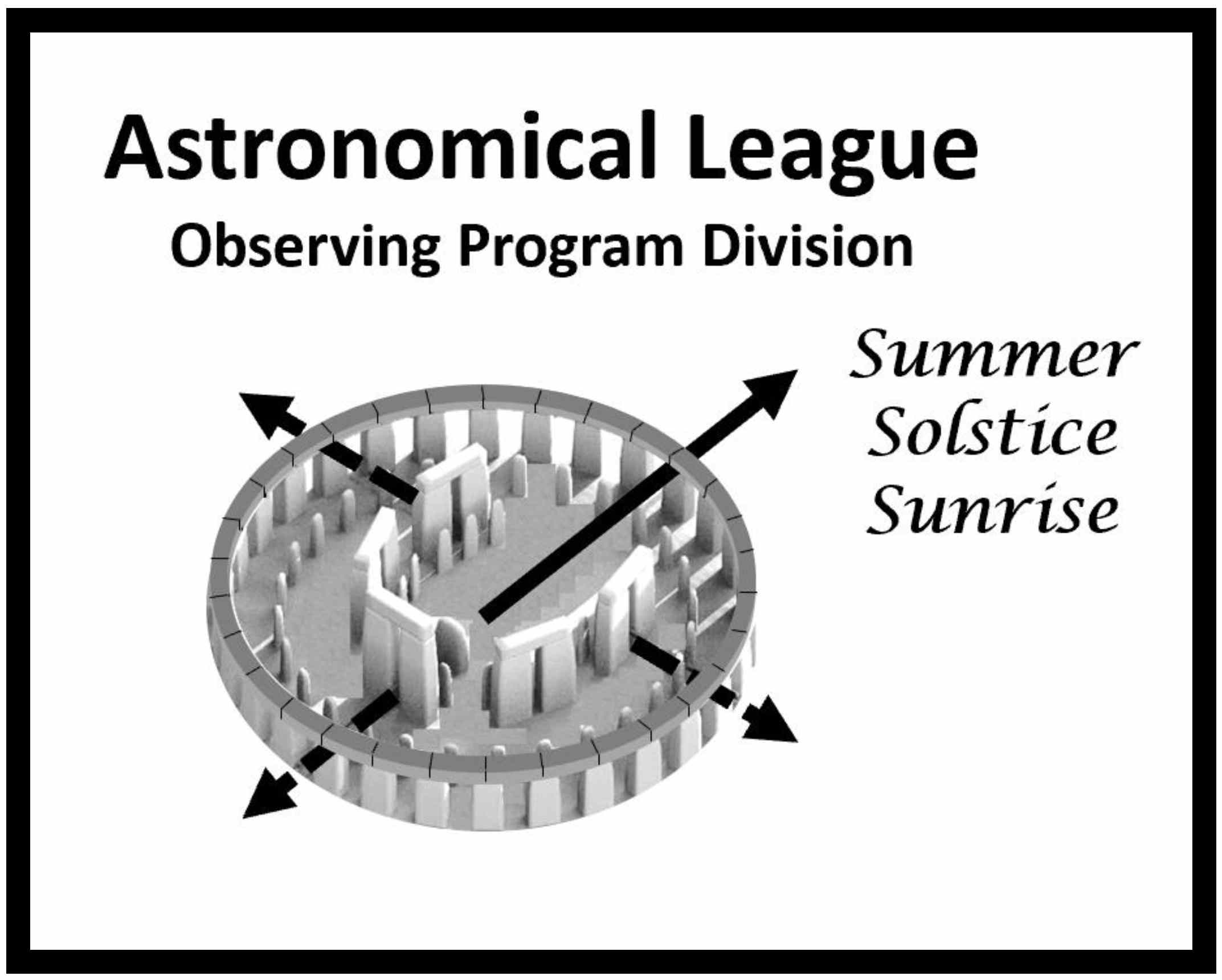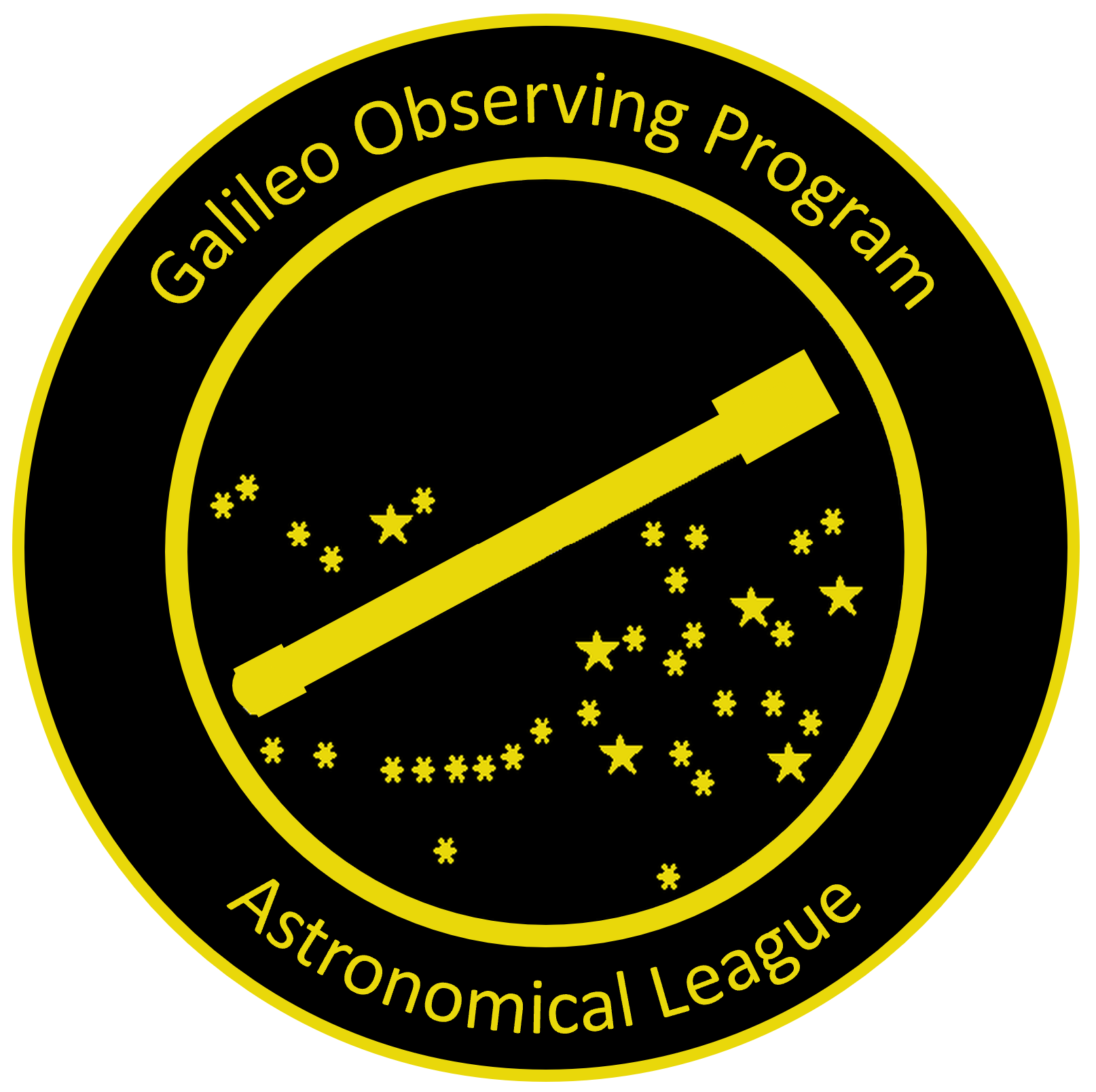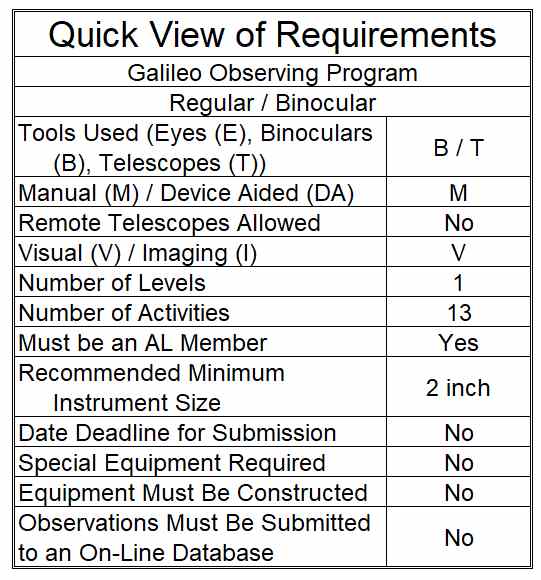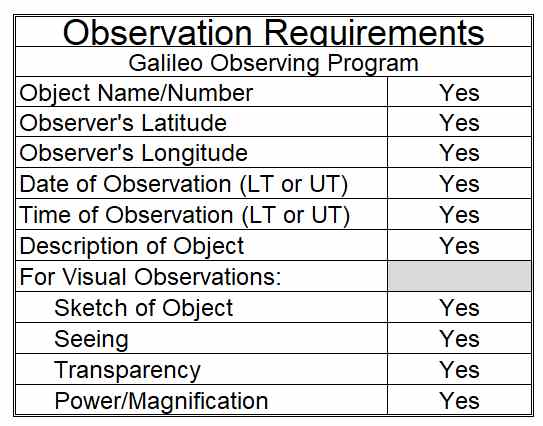Galileo Observing Program Coordinator:Mike Hotka |
  |
Introduction
| Welcome to the Astronomical League’s Galileo Observing Program. The purpose of this Observing Program is to experience the thrill that Galileo had when he was the first person to turn a telescope towards the sky. You will make observations like those that caused such a great uproar throughout Europe as you find evidence that shows that the Ptolemaic model of the Universe (geocentric) was wrong and that Copernicus might be right (heliocentric), and that Aristotle may not have been right either…
At the time of Galileo, the Universe was generally believed to be as Aristotle and Ptolemy envisioned it. The Earth was the center and everything revolved around us. Copernicus had proposed the idea that the planets all orbit the sun about 100 years earlier, but his solution was inaccurate when predicting the future behaviors of the planets. Aristotle’s premise was that the heavens were made of a fifth, “divine element” and that: “The universe is uncompounded, ungenerated, eternal, unalterable, and neither heavy nor light.” This implies that things are perfect in space (the Moon and beyond). So objects are spheres and travel in circles. They are flawless and have no detailed features. Picture yourself as Galileo Galilei. It is the turn of the century; the 17th century! It is the early 1600’s and you are a scientist and mathematician. You see your role to help determine how the universe works. You are not happy with the scientific philosophers who use logic to prove their theories. You believe in experimentation and observation, and you have a brand new tool, a telescope (which incidentally you made yourself). It is June of 1609 and it is only 3-power, but you quickly follow that with one of 8-power and then another with 20-power in October. So much to see, that nobody has seen before. |
 |
Levels of the Galileo Observing Program
Galileo Eyes Only Certification: This is a partial certification available for the Galileo Observing Program. For those completing the Naked-Eye requirements a certificate is available. It is suitable to meet the requirements of the For Your Eyes Only Observer Award and a certificate will be issued, but it is not suitable for the other Master Observer Progression Awards. No telescope or binocular observations may be included in the Eyes Only Galileo Certification. You must obseve at least three (3) of the targets marked with an (*E*) on the list of targets.
Galileo Binocular Certification: This is one option for the regular certification available for the Galileo Observing Program. For those completing the requirements naked-eye or with binoculars, a certificate and pin will be awarded. This certification is suitable to meet the requirements of the Binocular Master Observer Award as well as the other Master Observer Progression Awards. No telescope observations may be included in the Binocular Galileo Certification.
Galileo Regular Certification: This is another option for the regular certification . All observations are required . Eye Only observations as well as some Binocular observations are acceptable, but most should be done using a telescope. A pin and certificate will be awarded.
Definition of Binoculars Allowed for Binocular Observations and Certifications
The Astronomical League defines a binocular telescope as an observing device with two optical tubes and two eyepieces, where the eyepieces can be replaced with eyepieces of different focal lengths. “Bino-Viewers” have a single optical tube, but two eyepieces. “Bino-Viewers” and Binocular Telescopes may be used in any Observing Programs that are telescope-based. They may not be used in binocular programs.
Observing devices with two optical tubes and two eyepieces, where you cannot change the eyepieces, are binoculars. Binoculars may be used in any Observing Program requiring telescopes or binoculars. Most binoculars do not have sufficient magnification to replace telescopes.
Requirements and Rules
This certification is available to members of the Astronomical League, either through their local astronomical society or as Members-at-Large. If you are not a member and would like to become one, check with your local astronomical society, search for a local society on the Astronomical League Website, or join as a Member-at-Large
| All observations must be done at a magnification between 10 and 20. Either binoculars or a telescope may be used. The instrument should be mounted to provide adequate stability. Go-To equipment is allowed. Two types of certificates will be issued. One will be for those observers who certify that they did all of their observations using binoculars and unaided eyes (Galileo Binocular Observing Program). The other is for those who employed any combination of a telescope, binoculars, and unaided eyes (Galileo Observing Program).
You must complete all of the requirements except those that are labeled “Optional”. The optional ones should be done if you are able, but by their nature, it is expected that many observers may not be able to do them. You should document:
|
 |
Repeat Galileo’s Observations of the Heavens:
- 1. December 24, 1604 – Supernovae (optional): The objective is to show that the heavens do change. Observe a naked-eye supernova in the Milky Way galaxy. Make a sketch of the sky during the supernova and one after the supernova has faded below the level of visibility. Estimate its maximum brightness. It should be noted that the last time a supernova was visible in the Milky Way galaxy was in the early 1600’s when Galileo observed one. (*E* if it is naked-eye visible)
 2. November 30 through December 19, 1609 – The Moon: The objective is to show that the moon is not a flawless sphere; it has mountains.
2. November 30 through December 19, 1609 – The Moon: The objective is to show that the moon is not a flawless sphere; it has mountains. Observe and sketch the moon. It may be done at any phase where enough detail can be seen to show that there are mountains and valleys on the moon. Near the first or last quarter phases is the best time for this observation. Include only the details that you can see. (*E*)
Observe and sketch the moon. It may be done at any phase where enough detail can be seen to show that there are mountains and valleys on the moon. Near the first or last quarter phases is the best time for this observation. Include only the details that you can see. (*E*)
- 3. January 1, 1610 – Jupiter’s moons: The objective is to show that all objects in the universe do not orbit the Earth. Observe and sketch Jupiter and its moons daily through at least one cycle of their orbits. This will be a minimum of 17 days, and you may have to do multiple orbits to get the entire orbits. From these sketches, note the dates and times of their greatest distance from Jupiter, and calculate the orbital periods of the four Galilean moons: Io, Europa, Ganymede, and Callisto.
- 4. 1612 – Jupiter’s moons in eclipse: The objective is to show that in addition to the moons being occulted by Jupiter, they also travel through Jupiter’s shadow and are eclipsed. Observe and sketch, noting the timing, one of Jupiter’s moons during an ingress or egress with Jupiter’s shadow. Callisto or Ganymede is the most dramatic. Two observations should be made. One should be close to when Jupiter is in opposition. The second should be done when Jupiter is at quadrature (90 degrees from the
 Sun). Note how close to the planet the moon is when the event occurred. (Editor’s note: At least two observations and timings are required.)
Sun). Note how close to the planet the moon is when the event occurred. (Editor’s note: At least two observations and timings are required.) - 5. 1610 – Orion’s Head Nebula: The objective is to show that there are more stars visible through a small telescope than there are with the naked eye. Observe and sketch the region at the head of Orion (the star is called Meissa or Lambda Orionis). You will note that what looks like 1 star naked eye is actually 3 bright stars and many lesser ones. Sketch what you see. Galileo was able to see 20 in a region about 2 degrees across. North is up in this sketch. (*E* assuming you can see more than one star)
 6. Praesepe Nebula: The objective is to show that there are more stars visible through a small telescope than there are using just the eyes. Observe and sketch the area of M44 in Cancer. In a field of about 3.5 degrees, stretching from Asellus Australis to Ausellus Borealis Galileo was able to see 38 stars. North is up in this sketch.
6. Praesepe Nebula: The objective is to show that there are more stars visible through a small telescope than there are using just the eyes. Observe and sketch the area of M44 in Cancer. In a field of about 3.5 degrees, stretching from Asellus Australis to Ausellus Borealis Galileo was able to see 38 stars. North is up in this sketch.
 7. Pleiades Nebula: The objective is to show that there are more stars visible through a small telescope than there are using just the eyes. Observe and sketch the area of M45 in Taurus. (*E* if you can see more than one star)
7. Pleiades Nebula: The objective is to show that there are more stars visible through a small telescope than there are using just the eyes. Observe and sketch the area of M45 in Taurus. (*E* if you can see more than one star)- 8. July 1610 – Saturn’s Ears: The objective is to show that Saturn does not appear as a perfect sphere. Observe and sketch Saturn. The sketch should show that Saturn is not a perfect sphere. The rings do not appear as rings at this power, but appear as ears on the planet.


- 9. December 1610 – Venus phases: The objective is to show that Venus has phases like the moon, that it changes in size dramatically, and that one cycle of the phases is rather long.
- *** Be careful. Do not observe Venus when it is near the Sun. ***
- Observe and sketch Venus monthly through at least a half cycle of phases. Since Venus is not visible when it is in the full or new phases, you can do this from the time it first appears in the morning or evening sky until the last time it is visible. Calculate the length of the cycle and be sure to capture the relative size of Venus.
- 10. May 1611 – Sunspots: The objective is to show that the sun is not perfect (has sunspots) and is rotating. Observe one large spot that completes one complete rotation of the sun. Note that sunspots are renumbered each time they appear, even if it is a spot that was visible on the previous rotation. Use ONLY pinhole projection to meet this requirement. Other forms of observation will not be counted. Full-face sketches should be made about once per week. Sunspots measured should be fairly close to the solar equator and measurements should be done from meridian crossing to meridian crossing. What is the rotational period for the sun near its equator? For more information on Safely Observing the Sun, click here. (*E* if they are visible using Pin-Hole Projection)
*** WARNING ***
Before you start any solar observing program, make absolutely certain that you have safe filters and a safe set-up. Only use filters from reputable sources, and never use a “solar filter” that screws into an eyepiece. As Richard Hill states in Observe and Understand the Sun: “Observing the sun is the only inherently dangerous observing an amateur astronomer can do. Be aware of this at all times and take all necessary precautions. If you do not know a filter or procedure is safe then do not use it! Always err on the side of safety. An eye once damaged is forever damaged. Filters that let too much INFRARED light through can burn an eye if used visually. There is NO PAIN when this happens. Burned retinas can not be repaired. Excessive ULTRAVIOLET light has been shown to cause cataracts. So be very careful.”
For more information on ways to safely observe the sun and how to use pinhole projection, click here.
 11. October 1618 – Comets: The objective is to show that the path of a comet is not a straight line through the sky. Make at least three observations of a comet and plot its progress among the stars. Although you will not do the calculations, this data is enough to show that the comet is not moving in a straight line through space. (*E* if visible naked-eye)
11. October 1618 – Comets: The objective is to show that the path of a comet is not a straight line through the sky. Make at least three observations of a comet and plot its progress among the stars. Although you will not do the calculations, this data is enough to show that the comet is not moving in a straight line through space. (*E* if visible naked-eye)- 12. February 1619 – Neptune: Although Galileo observed Neptune, he did not recognize that it was anything other than another star. Observe Neptune and sketch what you see in your field of view.
- 13. 1619 – Aurora (Optional): Galileo coined the term Aurora Borealis for the Northern Lights. He was mistaken in that he thought it was sunlight reflecting off of the Earth’s Atmosphere. Observe and sketch either the Aurora Borealis or the Aurora Australis. (*E*)
Submitting for CertificationThis Observing Program has a pin and certificate for those who successfully complete all of the required activities. Once you have made the necessary observations and sketches, either send copies of them to the Galileo Program Coordinator, or have them reviewed and approved by an officer of your local club. Be sure to indicate if your observations were all done using binoculars and unaided eyes (Galileo Binocular Observing Program). That officer should then send an email to the Galileo Observing Program Coordinator with your name, affiliated society, email address, and mailing address. Also, send the name and address of the person to whom the pin and certificate should be sent. A member may earn both versions of the certification, but only one pin will be issued. |
 |
| Galileo Program Coordinator:
Mike Hotka (303) 818-8956mhotka@yahoo.com
Upon verification of your submission and of your active membership in the Astronomical League, your recognition (certificate, pin, etc.) will be sent to you or to the awards coordinator for your society, as you specified. Your name will also appear in an upcoming issue of the Reflector magazine and in the Astronomical League’s online database. Congratulations. Good luck with your next observing challenge.
|
|
Notes:
- Galileo’s TOES: The Galilean Moons that orbit Jupiter are in a continual dance with the planet. For those who take the time and make the effort, we have developed an award (certificate) to recognize their accomplishment. For information about this certification, click: Galileo’s TOES.



